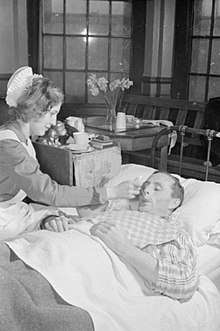Assisted feeding
Assisted feeding, also called hand feeding or oral feeding, is the action of a person feeding another person who cannot otherwise feed themselves. The term is used in the context of some medical issue or in response to a disability, such as when a person living with dementia is no longer able to manage eating alone. The person being fed must be able to eat by mouth, but lacks either the cognitive or physical ability to self-feed. Individuals who are born with a disability like cerebral palsy, or arthrogryposis multiplex congenita (AMC) may be unable to feed themselves. Also, those who acquire a disability due to an accident or a disease like amyotrophic lateral sclerosis (ALS) may require hand feeding because they may become unable to pick-up and bring food to their own mouth. Guidance about safely assisting people to eat can be found at the Feeding the Disabled website.

Also there are devices available that many people who cannot feed themselves can use to give them control over their eating. Please refer to the Wikipedia topic “Assistive eating devices” for information about these devices.
Assisted feeding as an alternative to tube feeding
A feeding tube is a medical device used to provide nutrition to patients who cannot obtain nutrition by mouth, are unable to swallow safely, or need nutritional supplementation.[1] [1] Patients who are able to use assisted feeding should have that in preference to tube feeding whenever possible.[1]
Oral assisted feedings are preferable to percutaneous feeding in individuals with advanced dementia.[2]
Monetary costs
In the United States a study reviewed a set of patients and found that the expenses to arrange assisted feeding for patients was higher than the cost of using a feeding tube.[3]
Further reading
- Rabin, Roni Caryn (2 August 2010). "Feeding Dementia Patients With Dignity". The New York Times. New York: NYTC. ISSN 0362-4331. Retrieved 22 January 2014.
References
- Gillick, M. R. (2000). "Rethinking the Role of Tube Feeding in Patients with Advanced Dementia". New England Journal of Medicine. 342 (3): 206–210. doi:10.1056/NEJM200001203420312. PMID 10639550.
- AMDA – The Society for Post-Acute and Long-Term Care Medicine (February 2014), "Ten Things Physicians and Patients Should Question", Choosing Wisely: an initiative of the ABIM Foundation, AMDA – The Society for Post-Acute and Long-Term Care Medicine, retrieved 20 April 2015.
- Mitchell, S. L.; Buchanan, J. L.; Littlehale, S.; Hamel, M. B. (2004). "Tube-Feeding Versus Hand-Feeding Nursing Home Residents with Advanced Dementia: A Cost Comparison". Journal of the American Medical Directors Association. 5 (2): S23. doi:10.1016/S1525-8610(04)70086-9.